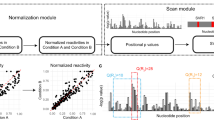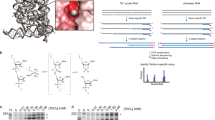Abstract
Sequencing-based RNA structure probing can generate transcriptome-wide profiles of RNA secondary structures. Sufficient structural coverage is needed to obtain unbiased insights about RNA structures and functions, yet probing methods often yield uneven coverage, with missing structural scores across many transcripts. To overcome this barrier, we developed StructureImpute, a deep learning framework inspired by depth completion from computer vision that integrates an RNA sequence with available RNA structural information of neighbouring nucleotides to infer missing structure scores. We demonstrate the strong imputation performance of StructureImpute, with accuracy much superior to predictions based on RNA sequence alone. We also show that StructureImpute reliably reconstructs RNA structural patterns at biologically impactful RNA regulation regions, including protein-binding and RNA-modification sites. Strikingly, StructureImpute can use transfer learning to apply a model trained on one dataset to accurately infer missing structural scores in other datasets, even if they were generated with different technologies (for example, icSHAPE and DMS-seq).
This is a preview of subscription content, access via your institution
Access options
Access Nature and 54 other Nature Portfolio journals
Get Nature+, our best-value online-access subscription
$29.99 / 30 days
cancel any time
Subscribe to this journal
Receive 12 digital issues and online access to articles
$119.00 per year
only $9.92 per issue
Buy this article
- Purchase on Springer Link
- Instant access to full article PDF
Prices may be subject to local taxes which are calculated during checkout






Similar content being viewed by others
Data availability
The raw icSHAPE sequencing data were downloaded from the Gene Expression Omnibus (GEO). HEK293 whole-cell data are from GSE7435326, including both in vivo and in vitro conditions. HEK293 subcellular component (chromatin-associated, nucleoplasmic, cytoplasmic) data are from GSE117840. The m6A modification sites are from the RMBbase database46, which provides a file in .bed format with genomic coordinates of the hg38 assembly. The binding regions of the FXR2 RNA binding protein are from the CLIPDB database44, which provides a file in .bed format with hg38 assembly genomic coordinates. All the processed data are available from figshare at https://doi.org/10.6084/m9.figshare.1660685058.
Code availability
Code used for training models and performing analyses are available from GitHub (https://github.com/Tsinghua-gongjing/StructureImpute) or Zenodo (https://doi.org/10.5281/zenodo.5501018)59.
References
Halvorsen, M., Martin, J. S., Broadaway, S. & Laederach, A. Disease-associated mutations that alter the RNA structural ensemble. PLoS Genet. 6, e1001074 (2010).
Wapinski, O. & Chang, H. Y. Long noncoding RNAs and human disease. Trends Cell Biol. 21, 354–361 (2011).
Bevilacqua, P. C., Ritchey, L. E., Su, Z. & Assmann, S. M. Genome-wide analysis of RNA secondary structure. Annu. Rev. Genet. 50, 235–266 (2016).
Piao, M., Sun, L. & Zhang, Q. C. RNA regulations and functions decoded by transcriptome-wide RNA structure probing. Genomics Proteomics Bioinformatics 15, 267–278 (2017).
Strobel, E. J., Yu, A. M. & Lucks, J. B. High-throughput determination of RNA structures. Nat. Rev. Genet. 19, 615–634 (2018).
Rouskin, S., Zubradt, M., Washietl, S., Kellis, M. & Weissman, J. S. Genome-wide probing of RNA structure reveals active unfolding of mRNA structures in vivo. Nature 505, 701–705 (2014).
Ding, Y. et al. In vivo genome-wide profiling of RNA secondary structure reveals novel regulatory features. Nature 505, 696–700 (2014).
Weng, X. et al. Keth-seq for transcriptome-wide RNA structure mapping. Nat. Chem. Biol. 16, 489–492 (2020).
Merino, E. J., Wilkinson, K. A., Coughlan, J. L. & Weeks, K. M. RNA structure analysis at single nucleotide resolution by selective 2′-hydroxyl acylation and primer extension (SHAPE). J. Am. Chem. Soc. 127, 4223–4231 (2005).
Siegfried, N. A., Busan, S., Rice, G. M., Nelson, J. A. & Weeks, K. M. RNA motif discovery by SHAPE and mutational profiling (SHAPE-MaP). Nat. Methods 11, 959–965 (2014).
Spitale, R. C. et al. Structural imprints in vivo decode RNA regulatory mechanisms. Nature 519, 486–490 (2015).
Arisdakessian, C., Poirion, O., Yunits, B., Zhu, X. & Garmire, L. X. DeepImpute: an accurate, fast, and scalable deep neural network method to impute single-cell RNA-seq data. Genome Biol. 20, 211 (2019).
Kiselev, V. Y., Andrews, T. S. & Hemberg, M. Challenges in unsupervised clustering of single-cell RNA-seq data. Nat. Rev. Genet. 20, 273–282 (2019).
Seetin, M. G. & Mathews, D. H. RNA structure prediction: an overview of methods. Methods Mol. Biol. 905, 99–122 (2012).
Mathews, D. H., Turner, D. H. & Watson, R. M. RNA secondary structure prediction. Curr. Protoc. Nucleic Acid Chem. 67, 11.12.11–11.12.19 (2016).
Shi, B. et al. RNA structural dynamics regulate early embryogenesis through controlling transcriptome fate and function. Genome Biol. 21, 120 (2020).
Sun, L. et al. RNA structure maps across mammalian cellular compartments. Nat. Struct. Mol. Biol. 26, 322–330 (2019).
Li, W. V. & Li, J. J. An accurate and robust imputation method scImpute for single-cell RNA-seq data. Nat. Commun. 9, 997 (2018).
van Dijk, D. et al. Recovering gene interactions from single-cell data using data diffusion. Cell 174, 716–729 (2018).
Huang, M. et al. SAVER: gene expression recovery for single-cell RNA sequencing. Nat. Methods 15, 539–542 (2018).
Xiong, L. et al. SCALE method for single-cell ATAC-seq analysis via latent feature extraction. Nat. Commun. 10, 4576 (2019).
Qiu, J. X. et al. DeepLiDAR: Deep surface normal guided depth prediction for outdoor scene from sparse LiDAR data and single color image. In Proc. IEEE Conference on Computer Vision and Pattern Recognition 3308–3317 (IEEE, 2019); https://doi.org/10.1109/Cvpr.2019.00343
Xu, Y. et al. Depth completion from sparse LiDAR data with depth-normal constraints. In Proc. IEEE International Conference on Computer Vision 2811–2820 (IEEE, 2019); https://doi.org/10.1109/Iccv.2019.00290
Tang, J., Tian, F. P., Feng, W., Li, J. & Tan, P. Learning guided convolutional network for depth completion. IEEE Trans. Image Process. 30, 1116–1129 (2021).
Li, P., Shi, R. & Zhang, Q. icSHAPE-pipe: a comprehensive toolkit for icSHAPE data analysis and evaluation. Methods 178, 96–103 (2020).
Lu, Z. et al. RNA duplex map in living cells reveals higher-order transcriptome structure. Cell 165, 1267–1279 (2016).
He, K. M., Zhang, X. Y., Ren, S. Q. & Sun, J. Deep residual learning for image recognition. In Proc. IEEE Conference on Computer Vision and Pattern Recognition 770–778 (IEEE, 2016); https://arxiv.org/abs/1512.03385
Hochreiter, S. & Schmidhuber, J. Long short-term memory. Neural Comput. 9, 1735–1780 (1997).
Singh, J., Hanson, J., Paliwal, K. & Zhou, Y. RNA secondary structure prediction using an ensemble of two-dimensional deep neural networks and transfer learning. Nat. Commun. 10, 5407 (2019).
Anger, A. M. et al. Structures of the human and Drosophila 80S ribosome. Nature 497, 80–85 (2013).
Bernier, C. R. et al. RiboVision suite for visualization and analysis of ribosomes. Faraday Discuss. 169, 195–207 (2014).
Bellaousov, S., Reuter, J. S., Seetin, M. G. & Mathews, D. H. RNAstructure: web servers for RNA secondary structure prediction and analysis. Nucleic Acids Res. 41, W471–W474 (2013).
Mautner, S. et al. ShaKer: RNA SHAPE prediction using graph kernel. Bioinformatics 35, i354–i359 (2019).
Selvaraju, R. R. et al. Grad-CAM: visual explanations from deep networks via gradient-based localization. In Proc. IEEE International Conference on Computer Vision 618–626 (IEEE, 2017); https://doi.org/10.1109/ICCV.2017.74
Zhou, B., Khosla, A., Lapedriza, A., Oliva, A. & Torralba, A. Learning deep features for discriminative localization. In Proc. IEEE Conference on Computer Vision and Pattern Recognition 2921–2929 (IEEE, 2016); https://arxiv.org/abs/1512.04150
Hentze, M. W., Castello, A., Schwarzl, T. & Preiss, T. A brave new world of RNA-binding proteins. Nat. Rev. Mol. Cell Biol. 19, 327–341 (2018).
Lu, Z. & Chang, H. Y. The RNA base-pairing problem and base-pairing solutions. Cold Spring Harb. Perspect. Biol 10, a034926 (2018).
Yan, Z. et al. Genome-wide colocalization of RNA-DNA interactions and fusion RNA pairs. Proc. Natl Acad. Sci. USA 116, 3328–3337 (2019).
Luo, Z., Yang, Q. & Yang, L. RNA structure switches RBP binding. Mol. Cell 64, 219–220 (2016).
Sanchez de Groot, N. et al. RNA structure drives interaction with proteins. Nat. Commun. 10, 3246 (2019).
Lewis, C. J., Pan, T. & Kalsotra, A. RNA modifications and structures cooperate to guide RNA–protein interactions. Nat. Rev. Mol. Cell Biol. 18, 202–210 (2017).
Huang, J. & Yin, P. Structural insights into N6-methyladenosine (m6A) modification in the transcriptome. Genomics Proteomics Bioinformatics 16, 85–98 (2018).
Lukong, K. E., Chang, K. W., Khandjian, E. W. & Richard, S. RNA-binding proteins in human genetic disease. Trends Genet. 24, 416–425 (2008).
Yang, Y. C. et al. CLIPdb: a CLIP-seq database for protein-RNA interactions. BMC Genomics 16, 51 (2015).
Anderson, B. R., Chopra, P., Suhl, J. A., Warren, S. T. & Bassell, G. J. Identification of consensus binding sites clarifies FMRP binding determinants. Nucleic Acids Res. 44, 6649–6659 (2016).
Xuan, J. J. et al. RMBase v2.0: deciphering the map of RNA modifications from epitranscriptome sequencing data. Nucleic Acids Res. 46, D327–D334 (2018).
Zaccara, S., Ries, R. J. & Jaffrey, S. R. Reading, writing and erasing mRNA methylation. Nat. Rev. Mol. Cell Biol. 20, 608–624 (2019).
LeCun, Y., Bengio, Y. & Hinton, G. Deep learning. Nature 521, 436–444 (2015).
Garst, A. D., Edwards, A. L. & Batey, R. T. Riboswitches: structures and mechanisms. Cold Spring Harb. Perspect. Biol 3, a034926 (2011).
Wan, Y. et al. Landscape and variation of RNA secondary structure across the human transcriptome. Nature 505, 706–709 (2014).
Lackey, L., Coria, A., Woods, C., McArthur, E. & Laederach, A. Allele-specific SHAPE-MaP assessment of the effects of somatic variation and protein binding on mRNA structure. RNA 24, 513–528 (2018).
Li, P. et al. Integrative analysis of Zika virus genome RNA structure reveals critical determinants of viral infectivity. Cell Host Microbe 24, 875–886 (2018).
Zhang, Z. et al. Deep-learning augmented RNA-seq analysis of transcript splicing. Nat. Methods 16, 307–310 (2019).
Flynn, R. A. et al. Transcriptome-wide interrogation of RNA secondary structure in living cells with icSHAPE. Nat. Protoc. 11, 273–290 (2016).
Grant, C. E., Bailey, T. L. & Noble, W. S. FIMO: scanning for occurrences of a given motif. Bioinformatics 27, 1017–1018 (2011).
Andronescu, M., Bereg, V., Hoos, H. H. & Condon, A. RNA STRAND: the RNA secondary structure and statistical analysis database. BMC Bioinformatics 9, 340 (2008).
Kalvari, I. et al. Rfam 13.0: shifting to a genome-centric resource for non-coding RNA families. Nucleic Acids Res. 46, D335–D342 (2018).
Jing, G., Kui, X. & Qiangfeng Cliff, Z. A deep learning method for recovering missing signals in transcriptome-wide RNA structure profiles from probing experiments. figshare https://doi.org/10.6084/m9.figshare.16606850 (2021).
Jing, G. & Kui, X. Tsinghua-gongjing/StructureImpute: v1.0.0. Zenodo https://doi.org/10.5281/zenodo.5501018 (2021).
Acknowledgements
This work was supported by the National Natural Science Foundation of China (grant numbers 91740204, 91940306 and 31761163007 to Q.C.Z.) and the Chinese Ministry of Science and Technology (grant numbers 2019YFA0110002 and 2018YFA0107603 to Q.C.Z.). We thank the Tsinghua University Branch of China National Center for Protein Sciences (Beijing) for computational facility support.
Author information
Authors and Affiliations
Contributions
Q.C.Z. and Z.J.L. conceived and supervised the research. J.G. and K.X. designed and implemented the StructureImpute model. J.G. designed and performed all the analyses with the help of Z.M. J.G. and Q.C.Z. wrote the manuscript with input from all authors.
Corresponding author
Ethics declarations
Competing interests
The authors declare no competing interests.
Additional information
Peer review information Nature Machine Intelligence thanks Zilu Zhou and the other, anonymous, reviewer(s) for their contribution to the peer review of this work.
Publisher’s note Springer Nature remains neutral with regard to jurisdictional claims in published maps and institutional affiliations.
Supplementary information
Supplementary Information
Supplementary Figs. 1–5 and Tables 1 and 2.
Rights and permissions
About this article
Cite this article
Gong, J., Xu, K., Ma, Z. et al. A deep learning method for recovering missing signals in transcriptome-wide RNA structure profiles from probing experiments. Nat Mach Intell 3, 995–1006 (2021). https://doi.org/10.1038/s42256-021-00412-0
Received:
Accepted:
Published:
Issue Date:
DOI: https://doi.org/10.1038/s42256-021-00412-0



